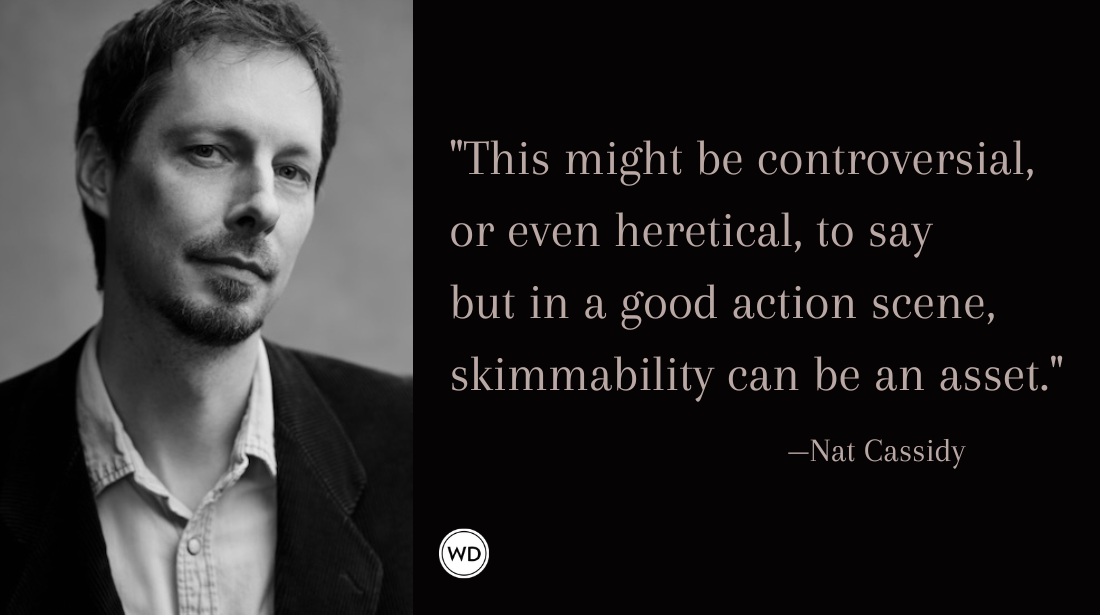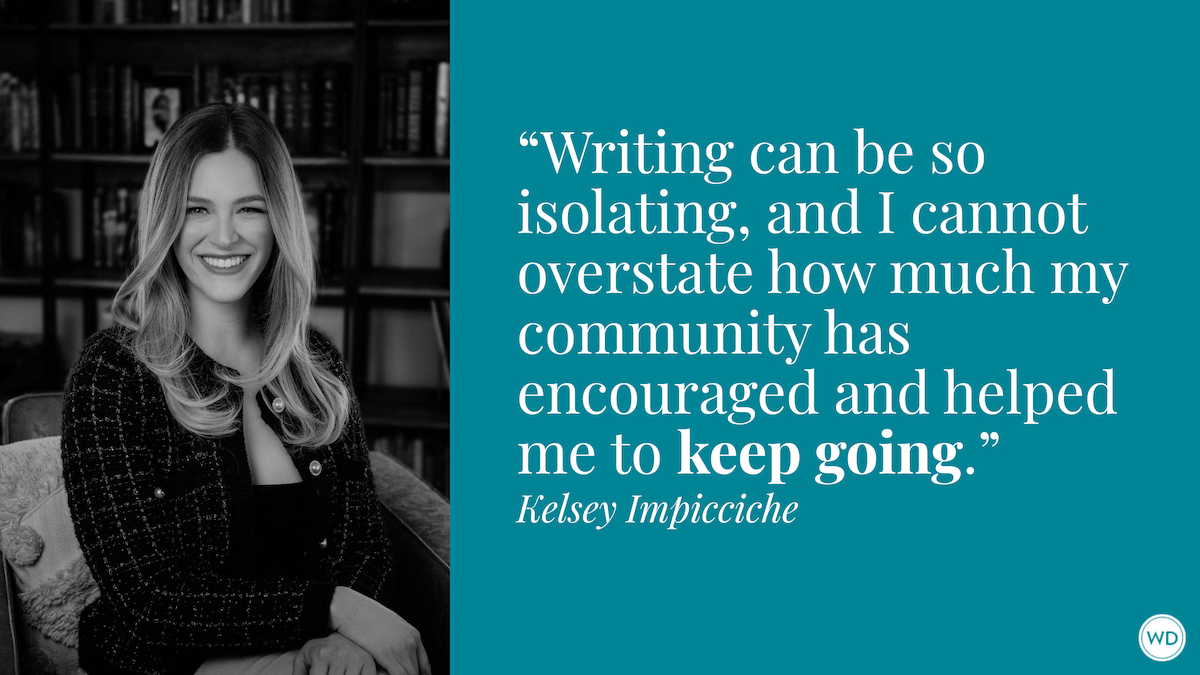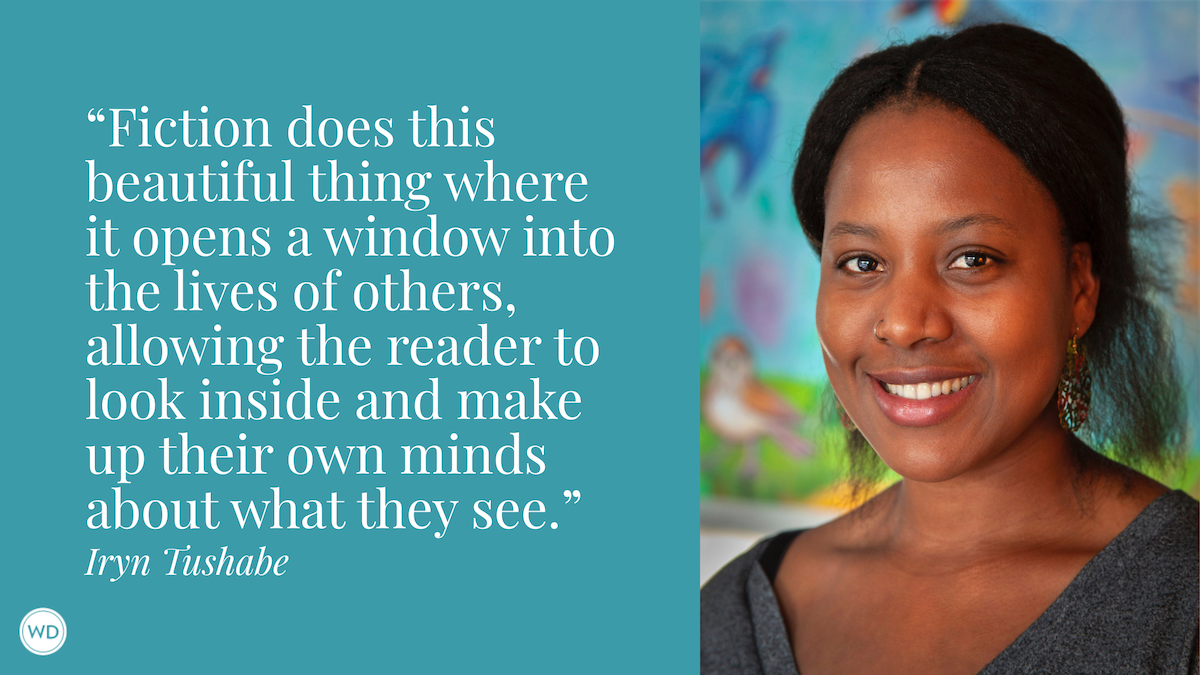How to Make Your Novel a Page Turner
Never underestimate the power of suspense—in any genre. Use these surefire techniques to make your book one that readers won’t be able to put down.
This article appeared in the January 2010 issue of Writer's Digest. For the full digital issue, click here.
When my father was a little boy, one of the last of the touring vaudeville companies came through his podunk town, and he got to see the show. The centerpiece was a one-act drama featuring a pretty girl in peril. The climactic scene began quietly, with her sitting next to a lamp, sewing. As the mustachioed villain sneaked onstage, the audience began to murmur in alarm. When the lovely young thing gave no sign of sensing the danger, the audience’s murmuring gained urgency and volume.
The innocent girl continued to sew her apron.
Closer crept the villain, drawing a knife from his coat.
In full voice now, the audience warned her: “Behind you. Turn around!”
When, incredibly, she bowed her vulnerable neck more deeply over her work, they rose from their seats, cupped their hands around their mouths, and shouted with the utmost diction: “Beee! hind! you! Look! beee! hind! yooooou!”
Unbearable suspense.
Ah, to be a master of it.
I used to beg my dad to tell that story, and I’d laugh maniacally every time. I fear that was what really sparked me to be a writer. The author of that playlet, subpar though it may be by today’s standards, accomplished what we all want: to hold audience members so firmly in our grasp they feel they’ve entered the story themselves.
And that, I guess, is a pretty good definition of a page-turner.
Today’s best novels make readers so desperate to know what happens next that they’ll stay up reading well past midnight, blistering thumbs and all, until THE END. Then and only then will they be able to relax, their souls flooded with satisfaction, relief, and peace. Only to be followed—ideally!—by a gnawing sense of unfulfillment, anxiety, and a compulsion to read more books by you.
It’s our responsibility to feed their addiction.
Looking at successful authors and their polished products, you might conclude they must have some literary alchemy at their fingertips, or they really are slightly superhuman, or they’ve made a deal with the devil. (If only it were so easy!)
But no: Writing a page-turner is an art and a craft. And you can learn to do it.
Plot From the Gut.
You’ve got a good idea for a story, you’ve got a few characters in your head, you’ve got some stuff that happens.
Now what?
At this point many people just start writing, hoping their book will take shape as they go.
The streets of New York are littered with queries from such authors.
To lift your work from the gum wads and pigeon merde, you need a coherent plot.
Now, you can get pretty complex with plotting. You can try to follow this or that guru’s rules, you can try to emulate this or that bestselling author. But if you do, you’ll likely find that the whole thing gets horribly complicated way too soon.
The following method for forging a compelling plot is as good as any, and simpler than all of them.
The HCM Plotting Method
- List the Heart-Clutching Moments you’ve already thought of—you know, those pivotal points in your story that will evoke all the intensity of that “look behind you!” response in your readers.
- Think of more.
- Construct your story around them. I emphasize the difference: Don’t focus on your loosely formed storyline. Focus on the key points in your story.
What Is an HCM?
- Love at first sight (Marius Pontmercy meets Cosette)
- A huge moral lapse (Judas takes the money)
- Murder (Miles Archer’s sets Sam Spade in motion)
- Death by other means (Injun Joe starves to death in the cave)
- A refusal of grace (Mayella Ewell sticks to her story in spite of taking the courtroom oath)
- Nature gone wild (shark dines on first recreational swimmer)
- Someone standing up to corruption (Shane picks up his gun again)
- A change of heart, for good or ill (Michael Corleone offers to kill Sollozzo and Captain McCluskey)
- An act of depraved violence (Bill Sykes cudgels Nancy)
- Betrayal (Sandy puts a stop to her mentor Jean Brodie)
- Forgiveness (Melanie insists Scarlett join her in the receiving line)
- A revelation (Pip’s secret benefactor is none other than … !)
HCMs can be active, whole scenes:
- A lifesaving attempt
- A chase
- A battle
- A seduction
- A caper
Make a list of Heart-Clutching Moments and put them on index cards in rough order. Then you can build an outline based on any form you desire, be it classical drama, farce, or anything in between. If you get stuck, do any of the following:
- Start writing one of your HCM scenes. Immediately the scene itself should prompt ideas, perhaps for new courses of action or even new characters.
- Write deeper into an HCM scene you’ve written already. You’ll likely find yourself coming up with bridges between scenes—and thinking of more elements to enhance your story.
- Look for places to add conflict, suffering, or frustration.
For example, Shakespeare wanted to take Macbeth from conquering hero to murderous traitor whose decapitation at the hands of one of his countrymen is the only possible, imaginable end.
How does he do it? Reread the play and you’ll realize that one HCM leads to the next, fast and furious: The witches’ stunning prophecies, Macbeth’s realization that he could be king, his wife’s corrupt ambition, one murder, two more murders, and more upon that, and prophesy again, and insanity, and suicide … all in the space of 98 pages!
Supercharge Your Cast of Characters
Readers get hooked on a novel when they meet a character they enjoy spending time with. Characters we love—or love to hate. How do you create them?
Let Your Reader Inside Their Heads
Sure, we see your characters in action, but show us their fears, their misgivings, their secret vanities. Many beginning writers expect the reader to assume too much along these lines. Let us know what your characters are thinking via inner monologues, dialogue, or even unexpected action. (“Yes, dear,” he sighed, giving the cat a discreet kick.)
Give a Character a Secret
Think Sophie’s Choice: You can bet William Styron, having thought of the choice first, built the whole novel backward from Sophie’s main, huge, character-defining Heart-Clutching Moment. If you bear in mind your character’s secret as you write, it will inform your whole novel, lending substance, and subtlety.
Build In a Lovable Quirk
In The Catcher in the Rye, Holden Caulfield is as cynical as they come—except when something charms him. Pure sincerity pierces his heart, whether it’s two nuns in a coffee shop or his naive yet sharp-witted little sister. Without that vulnerability, he’d be just another insufferable teen.
Create an Unpredictable Character
Shakespeare’s witches, Boo Radley, Kurtz. A character with a screw loose, or one hidden in the shadows, will prevent your readers from ever feeling safe. What will that devil do next?
Make Them Share
Do your research and, through your characters, share cool stuff you’ve learned about a time, place, person, or pursuit. The Day of the Jackal gives specific, compelling information as to how the assassin works. In his books, retired jockey Dick Francis brings us into horse breeding and racing. Other authors give deep detail on subjects ranging from domestic arts to international terrorism.
End Chapters With a Bang
The most important page turns in any book are those at the ends of the chapters. Why? Because readers tell themselves, “OK, I swear I will turn out the light at the end of this chapter because I am committed to going to yoga at 6:30.”
An alarming 40 percent* of readers who put a book down before finishing it never pick it up again. Stuff gets in the way: kids, work, “Columbo” reruns, the J. Crew catalog. So you’ve simply got to keep them reading to the end.
As a novice writer, I pondered that admonition. How was I supposed to do it? I couldn’t throw in a car wreck or an assassination or a dangling hero or a miraculous cure at the end of every single chapter; that would be ridiculous. Luckily, the answer came to me in the middle of my first novel, Holy Hell: You don’t create Heart-Clutching Moments in order to end a chapter. You end a chapter when you get to a naturally occurring HCM.
More specifically, when you come to a point just before or just after an HCM, break your chapter. This works every time. Realistically, of course, you don’t have 33 true HCMs in a book; you might have five, or 10. So in the meantime, break chapters at transitions:
- A turning point (where something or someone is about to change)
- A jump in time or place
- A shift in point of view
- A settling of the action
- A ramping-up of the action
These chapter breaks tend to be quieter, but no matter what, you must still give your readers a compelling reason to turn that page. It doesn’t have to be big: a pique, a hint, a whiff. More on that next.
Use Mood Like a Scalpel
My agent, Cameron McClure, is a demanding reader whose opinions I value. After reading my latest manuscript, she sent me notes, including one concerning the following chapter ending, in which the proprietor of a filling station in the storm-soaked Pacific Northwest is concluding a conversation with a visitor:
First Truck goes off without telling me, now Joey. The gas pump busts, and I’m here selling no gas. No garage work getting done either, I’m sure you notice. Turned away a brake job this morning.
Cameron wrote: “This isn’t a good way to end a chapter—it doesn’t feel over. You do such a good job with chapter endings, and making things feel both wrapped up, yet throwing in some detail or aspect that makes the reader want to read on and know more, that this half-assed chapter ending really sticks out. Can you fix?”
(Side note: As an author, you must develop the necessary dermatological depth to be OK when your own agent calls your work “half-assed.”)
I pondered her request and realized that I could add a feeling of menace and uncertainty. I left everything the way I had it, but added this paragraph to close the chapter with the internal thoughts of the visitor:
When I went out, the moss on the bulletin board looked like it’d grown an inch longer since I’d gone in. The moss, I realized, thrived on the heavy moisture in the air, and the wood that hosted it was decaying because of the same. The wet giveth, and the wet taketh away. Yeah, that was written all over this place.
The day after writing that, I gave a talk in a bookstore about reading and writing mysteries, and I used this as an example of working with an agent—if the agent has good suggestions, you take them. I read the original chapter ending to my audience, then my agent’s criticism of it. Then I read the added paragraph, and listened as they collectively made a soft little “yeah” sound.
Steal the Stuff of Good Suspense
No storyteller invents everything; to be honest, we steal stuff from one another all the time. Joseph Campbell figured it out in The Power of Myth and The Hero With a Thousand Faces, both of which are useful references for any writer. Humankind’s basic stories are always with us: sacrifice and bliss, love and death, adventure and gifts, war and peace. Scratch any good novel and you’ll find one or more seminal myths supporting the story, forming the framework for the characters and the action. And boy, every one of them is a page-turner.
Consider the best-known suspense tale in history, the Adam and Eve story from the Bible. From the moment you hear God tell Adam and Eve, “Whatever you do, don’t eat the fruit from that tree over there,” you know something bad is going to happen. You know they’re going to eat the fruit. You know you would eat the fruit. And you know how you would feel afterward: guilty. You broke the rules. You know there will be consequences. Dire consequences, given the setup.
And you keep reading to find out what happens.
The dudes who wrote the Bible were nobody’s fools.
Look back even further, to the story of Pandora, Greek mythology’s first woman, who was instructed by Zeus to never, never open that pretty box over there. Once alone with the box, does she just throw it open and scatter its contents?
No! She sits there and thinks about it. She gets up and paces. She agonizes, she wrings her hands, she convinces herself to open it, she convinces herself not to open it. She fights with the two sides of her nature: obedience and curiosity.
That myth came to mind when I was working on a chapter about a woman who receives a box from a messenger. The woman is a rich industrialist whose son has gone missing. She has shrugged off a ransom demand, believing her son is trying to trick her. Now, in the middle of a meeting with a private detective about another matter, this box comes, a beer carton sealed with duct tape.
It sits on her mahogany desk like a redneck at a tea party.
I could have made her tear it open, or I could have made the detective snatch it away, or I could have made it explode.
But whatever I was going to do, I sure as heck wasn’t going to do it fast. So I made that box sit on her desk while they argued about it.
Is it a joke?
A hoax?
Should we call the bomb squad?
Was I wrong about my son?
How am I going to handle this client if the box contains something potentially devastating?
Remember That Action Is Your Artillery
Use it strategically. Here are some plans of attack:
Let It Hang Fire, or Let It Go Off
Carefully delayed action, as in the example of Pandora’s box, works wonders to draw your readers’ nerves to the breaking point. But then you must pay it off. Someone barging in with a gun is always alarming, but something as small as a sneeze at an inopportune time can make your readers reach for their heart medicine.
Consider Constructing Your Entire Plot Around the Bull’s-Eye of Action
In John Steinbeck’s The Grapes of Wrath, the Joads embark on a journey, and immediately the journey itself lends structure, interest, and tension: Will they get to California? Will they find work? Will Tom get in trouble again? Where’s Rose of Sharon going to give birth: a ditch, a shed, a boxcar? Journeys can be literal or figurative. Of course, the journey plot is just one example of extended action.
Let Loose a Cannonade
Rapid-fire action is handy when you have to have dialogue to reveal information. Instead of sitting two characters on a porch, put them in a fast convertible and make one try to smoke a cigarette while they talk. Make a cop interrupt with a speeding ticket. Make them come upon a crash. Shove the conversation into the interstices of the action.
Develop Plot by Accidental Discharge
If a husband is going to slip and reveal an extramarital affair, make him do it while bringing his wife to climax. If a kid is going to stumble upon a secret, make him do it while chasing his escaped pet lizard.
When reading a good page-turner, analyze it. Ask yourself why it’s good, and you’ll find any number of these techniques. Then invite your subconscious to come up with some variations of your own.
Elizabeth Sims is the bestselling author of seven popular novels in two series, including The Rita Farmer Mysteries and The Lillian Byrd Crime series. She's also the author of the excellent resource for writers, You've Got a Book in You: A Stress-Free Guide to Writing the Book of Your Dreams, published by Writer's Digest Books.








